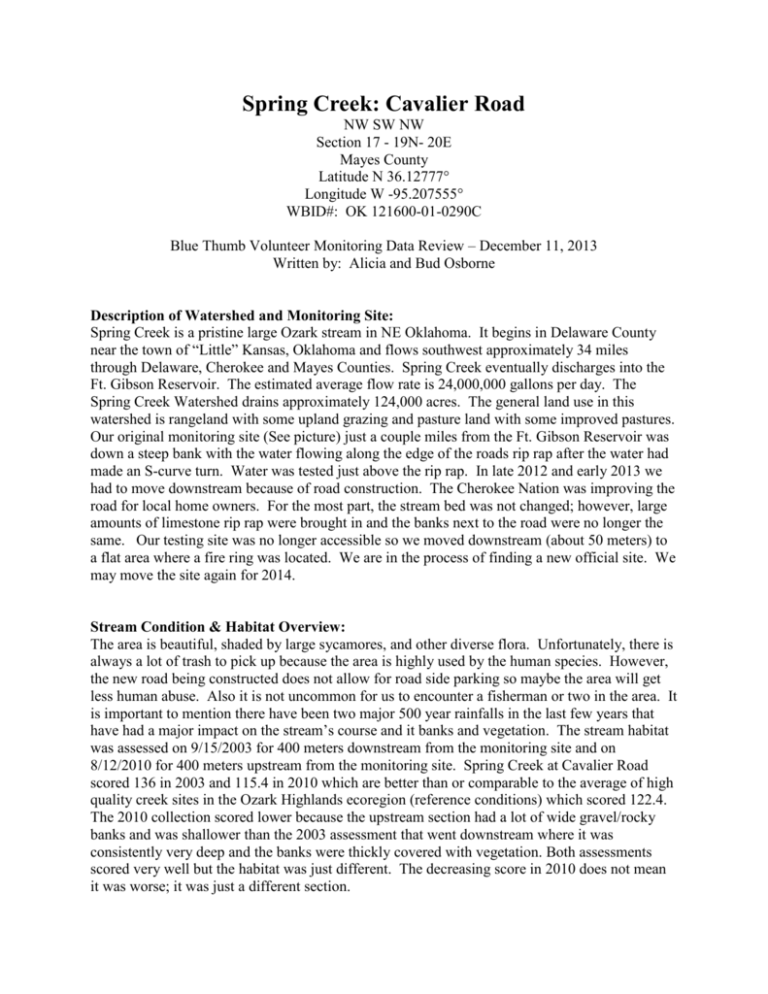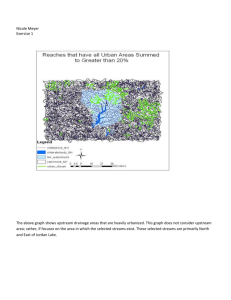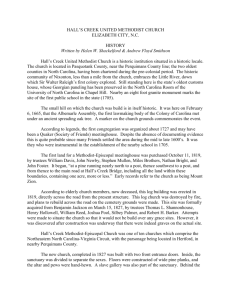Downstream - Spring Creek Coalition
advertisement

Spring Creek: Cavalier Road NW SW NW Section 17 - 19N- 20E Mayes County Latitude N 36.12777° Longitude W -95.207555° WBID#: OK 121600-01-0290C Blue Thumb Volunteer Monitoring Data Review – December 11, 2013 Written by: Alicia and Bud Osborne Description of Watershed and Monitoring Site: Spring Creek is a pristine large Ozark stream in NE Oklahoma. It begins in Delaware County near the town of “Little” Kansas, Oklahoma and flows southwest approximately 34 miles through Delaware, Cherokee and Mayes Counties. Spring Creek eventually discharges into the Ft. Gibson Reservoir. The estimated average flow rate is 24,000,000 gallons per day. The Spring Creek Watershed drains approximately 124,000 acres. The general land use in this watershed is rangeland with some upland grazing and pasture land with some improved pastures. Our original monitoring site (See picture) just a couple miles from the Ft. Gibson Reservoir was down a steep bank with the water flowing along the edge of the roads rip rap after the water had made an S-curve turn. Water was tested just above the rip rap. In late 2012 and early 2013 we had to move downstream because of road construction. The Cherokee Nation was improving the road for local home owners. For the most part, the stream bed was not changed; however, large amounts of limestone rip rap were brought in and the banks next to the road were no longer the same. Our testing site was no longer accessible so we moved downstream (about 50 meters) to a flat area where a fire ring was located. We are in the process of finding a new official site. We may move the site again for 2014. Stream Condition & Habitat Overview: The area is beautiful, shaded by large sycamores, and other diverse flora. Unfortunately, there is always a lot of trash to pick up because the area is highly used by the human species. However, the new road being constructed does not allow for road side parking so maybe the area will get less human abuse. Also it is not uncommon for us to encounter a fisherman or two in the area. It is important to mention there have been two major 500 year rainfalls in the last few years that have had a major impact on the stream’s course and it banks and vegetation. The stream habitat was assessed on 9/15/2003 for 400 meters downstream from the monitoring site and on 8/12/2010 for 400 meters upstream from the monitoring site. Spring Creek at Cavalier Road scored 136 in 2003 and 115.4 in 2010 which are better than or comparable to the average of high quality creek sites in the Ozark Highlands ecoregion (reference conditions) which scored 122.4. The 2010 collection scored lower because the upstream section had a lot of wide gravel/rocky banks and was shallower than the 2003 assessment that went downstream where it was consistently very deep and the banks were thickly covered with vegetation. Both assessments scored very well but the habitat was just different. The decreasing score in 2010 does not mean it was worse; it was just a different section. ORIGINAL SITE ORIGINAL SITE AT FLOOD STAGE (this rock was brought in about 1996) 2nd Site/Used when original site was occupied, during drought, when stream was at flood stage and/or during bridge and road construction. Biological Conditions: Fish Fish collections by seining were also conducted on the same days and same reaches at the habitat assessments. Using the average of high quality reference streams in this ecoregion as the benchmark, Spring Creek scored as well as reference in 2003 and better than reference in 2010. Total number of fish species: 17 in 2003, 19 in 2010, 17 for reference conditions. Sensitive benthic species (such as darters and madtoms) were slightly lower than the average, however, there was a slight increase in 2010 over those found in 2003. The number of species it takes to make up 75% of the total fish population decreased from 3 species in 2003 to 1 specie in 2010, reference conditions averaged 4 species. So the population diversity was not as good as it could be. The number of sunfish species also decreased from 5 in 2003 to 3 in 2010 but equals reference average of 3. The number of intolerant species has risen some from 2003 to 2010 as did the proportion of minnows that eat insects. This is all good to see as it indicates that the density of aquatic invertebrates is increasing which would imply the food base was improving. Overall the fish condition of Spring Creek at Cavalier Road ranked an “A” grade for both years (on a scale of A-E). Benthic Macroinvertebrates (bugs) Benthic Macroinvertebrates were collected in rocky riffles in the winters of 2003-205, 20072008, and 2010 and in the summers of 2003-207, 2010-2011. The 2003-2005 winter collections averaged a total score of 67% compared to reference. Scores increased to 75% in 2007 and 94% in 2008. The 2010 score fell to 50%. The sensitive bug species gradually increased from 2003-2005 (7species to 11 species) and then stayed steady around 9 species, reference averaged 13 species for the winter season. The total population of these sensitive species really dropped in 2010 as did population diversity and community balance. The summer collections were better than the winter collections and all but 2003 (“B” grade) had an “A” grade. The lowest score was summer 2003 of 80% and the highest was 107% in summer 2005. The numbers of sensitive bug species were very comparable to reference of 9 species except in 2004 which had 5 sensitive species. The population diversity in all the summer collections has been better than reference conditions. The balance of the communities has fluctuated showing some signs of pollution stress. Bacteria Screening: We have screened/tested several times for E. coli and found the count insignificant. We decided to discontinue this test. At this time, the data obtained does not imply this test to be necessary. In the future, if there are indicators that deem this test should be resumed, it will be reinstated. Chemical Testing: Chemical data was collected 2-8 times a year between 10/16/02 and 02/19/2013. DO Dissolved oxygen saturation shows when there are problems with the amount of oxygen available in the water for aquatic life. Too little or too much are indicators of problems. Chemical data show dissolved oxygen saturation levels generally follow the summer winter undulation. Overall we’ve seen a slight increase and the data points have been closer together. Oxygen levels are good. pH pH shows little variation with a range of 6.8 to 7.9 in a 11 year span. The mean over this time was 7.3 which is at a normal level. Nitrogen An estimate of soluble nitrogen is made by adding the amounts of ammonianitrogen and nitrate/nitrite-nitrogen found in the water. Levels of soluble nitrogen were most often in the normal range, below 0.8mg/L N. Four data points were above normal range and always due to Nitrate Nitrogen being 1.0mg/L N: 7/20/2007, 10/26/2009, 8/12/2010, and 11/18/2012. Ammonia nitrogen was never detected, nitrites rarely detected and 35% of the time nitrates were between 0.1mg/L N and 1mg/L N. Phosphorus About 36% of tests showed no detection. The other times were well within the normal range, but there is a trend that levels are increasing. Chloride Chloride consistently tests at 10-15mg/L Cl which is very normal for this area. Synopsis: Concerns: The changes that have occurred in the past 10 years are mostly due to flooding, extreme drought and road construction. Having lived on this creek for 35 years, we have seen a visual reduction in stream flow where we test, along with a definite increase in the amount of trash in the area. Being in contact with our neighbors along the creek (through Spring Creek Coalition) there has been a constant concern that too much water is being taking from the creek. Along with seeing trucks fill up their tanks at the creek, it is our understanding that a local water company that originated to serve the home on the creek has expanded over 30 miles to serve others. It is our opinion that the creek should be protected. Ft. Gibson Reservoir should be used to provide water rather than a creek which is an infant body of water and should not be exploited. Providing for people within a few miles of the creek is one thing but unlimited use and serving those farther is slowly deteriorating the creek. The need for responsible water use is slowly becoming a necessary reality and our continued monitoring will help provide data to support the preservation of Spring Creek. According to the data, it is still a model stream. In the next decade we hope to see it improve. Future Goals: 1. Establish new site. 2. Monitor more often and check the biological data to see if the overall food base continues to improve. 3. Once a new site is established, the flora and stream bank will be photographed and documented for future reference.







